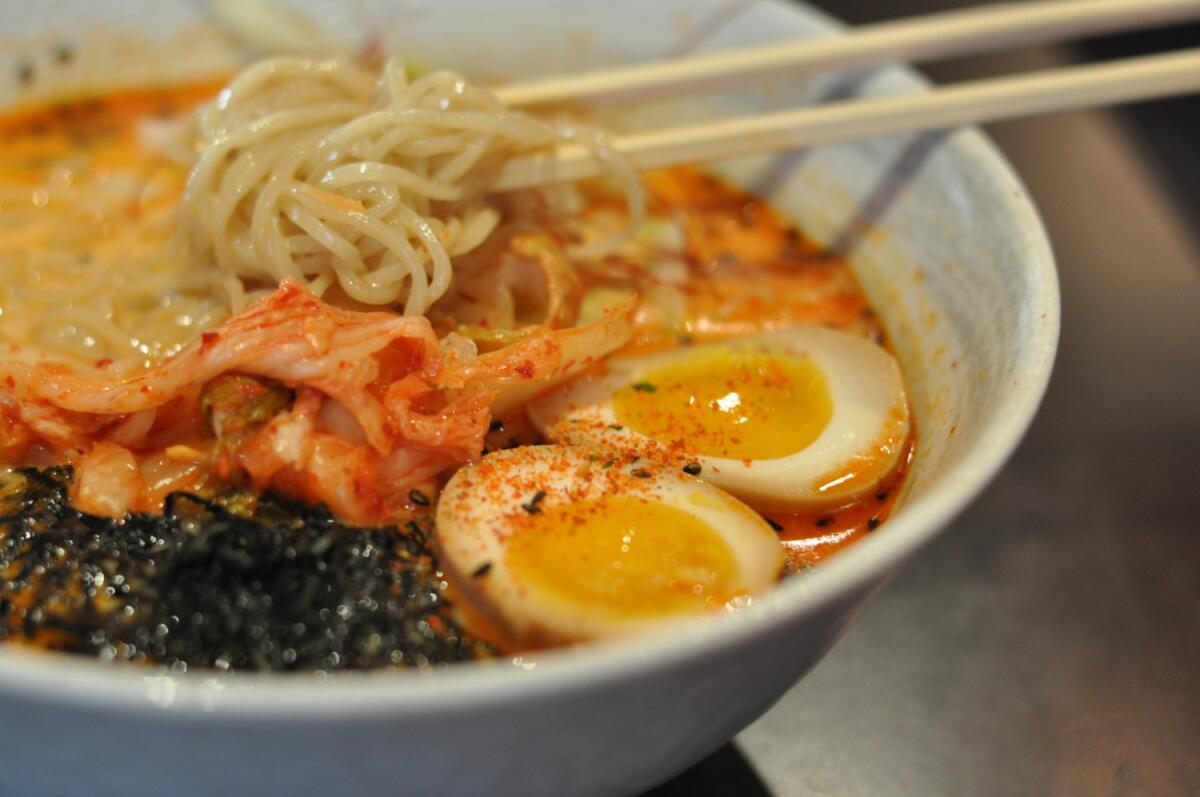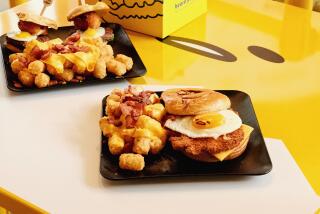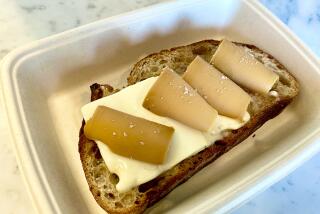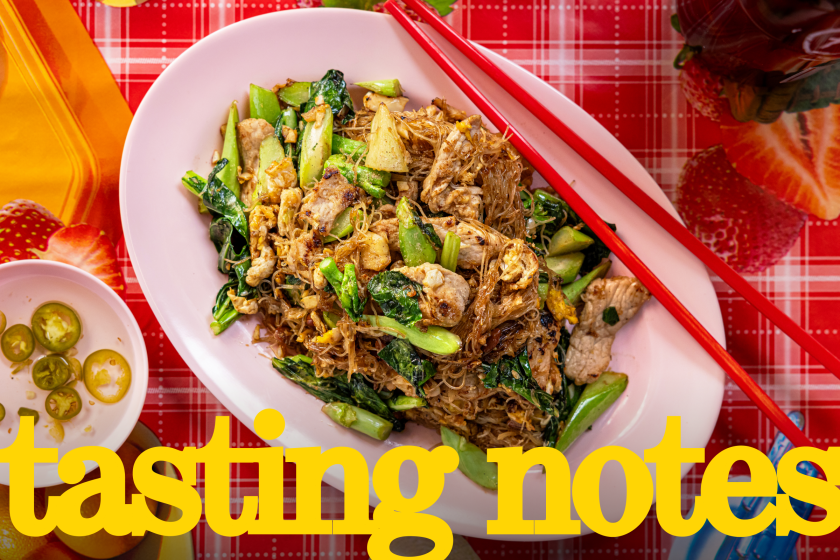Great dishes that taste better with an egg on top

Whether you’re a classically trained chef, a diner cook or a parent, there are many reasons to deliver an egg — fried, poached, sous-vide to a perfect 62 degrees — to the top of the dish or bowl on the table. Because although this has become a kind of repetitive default in the last few years, sometimes an egg is not just a way to incorporate protein into a dish or create an instant carbonara sauce. It can finish a dish, add a circle of bright color or simply make it breakfast.
“It’s a Hawaiian thing,” said Wes Avila the other day at his Guerrilla Tacos truck in downtown L.A. “There everybody’s like, ‘You want an egg on that, bra?’ That’s what made me want to do it.”
Maybe blame loco moco, particularly the near-legendary loco moco that’s long been on the menu at Animal, Jon Shook and Vinny Dotolo’s Fairfax Avenue restaurant. Built with foie gras, a hamburger, rice, gravy, Spam and a quail egg, Animal’s dish is a paean to cheffy comfort food.
“It actually started with no egg,” Shook said recently of the original dish. “The egg was added later. It was an alternative to a sandwich for high school kids who wanted something cheap and fast and filling. When we were developing the dish we wanted to add an egg — a little for look and little for taste.”
Certain dishes pretty much require an egg. The riot of ingredients in bibimbap doesn’t work without an egg to fuse them together. Some bowls of ramen need a halved egg, the exterior painted by soy sauce, the interior the texture of custard, to complete them. A proper steak tartare needs an egg, as does the perfect architecture of ikura sushi. A plate of frisee au lardon. A cauldron of soon tofu.
“We use eggs on dishes for a lot of different reasons; sometimes we use it to balance flavors or to add richness, texture or even to make a sauce tight,” Shook said. “Do I think some chefs are getting carried away with putting eggs on dishes? Yes. I believe it can be overkill sometimes. With that said, a lot people in a kitchen say an egg will always make it better.”
True enough, particularly in the case of these five dishes.
Loco moco — Since Animal opened its unmarked doors in 2008, the loco moco has been as close to a signature dish as you can find on the menu. With or without foie gras (according to the dictates of the now-rescinded foie ban, not Shook or Dotolo), the dish is a towering flavor bomb, atop which the egg sits like a kind of crown. A few miles west, Roy Choi recently put loco moco on his newly re-envisioned A-Frame, now a temple to Hawaiian comfort food. There the loco moco is loaded with a hamburger, rice, Japanese curry gravy, a sunny-side egg and pickled pearl onions.
Ramen — Most bowls of ramen hardly need an egg from a gastronomic standpoint, as there’s enough pork-intensive broth and slices of chashu to keep you from needing protein anytime soon. But an egg, cooked just until it’s the texture of custard and the color of the sun, then halved and placed atop the nest of noodles — this can be transformative. In fact, for many of us, these ajitsuke tamago can function as a quick litmus test for a good ramen-ya. (Checklist: chewiness of noodles, condition of broth, whether or not the egg is overcooked.) Let the hot broth warm the eggs from the soy-stained outside in, maybe nudge some of the slick of black garlic oil or spicy miso over the yolk, begin.
Breakfast sandwiches — Instead of debating what exactly defines a breakfast sandwich, consider what emerged recently from the window at Wes Avila’s Guerrilla Taco truck. On a grilled Mexican croissant, warm and slightly charred, Avila had layered mortadella, feathery greens from McGrath Family Farm, avocado, a few exquisite pickled radishes, fresh herbs — and a perfectly cooked duck egg. Get a cortado from Blacktop Coffee, outside of which Avila often parks his truck. Sit on the concrete sidewalk, not yet heated by the morning sun, and eat the whole thing, the yolk spilling over the greens.
Easter: Recipes, egg decorating tips, L.A. brunch restaurants and more >>
Bibimbap — If you have a bowl of cold bibimbap before you, the raw egg functions as the sauce (maybe with sesame oil and a hefty dose of chile paste) that binds the riot of vegetables and rice and everything else you might find together. If you have a hot stone pot of dolsot bibimbap, the egg functions in the same way, but gets cooked by the heat, becoming both binder and ingredient. Part of the fun, of course, is the mixing — whether you do it yourself or your server does it for you, in which case it’s the perfect synthesis of comfort food and the kind of table-side service that makes you actually miss the era of banquet food.
Things in a bowl — If you doubt that an egg can improve the contents of what’s in your bowl, go to Chego, where you will find an egg topping many of Roy Choi’s bowls of wildly flavorful comfort food. Because although eggs top way too many bowls these days, they suit Choi’s — maybe because there are so many things in there already. Thus the combination of pork belly, rice, gochujang and pickled radishes; of lemon grass, bok choy, Thai basil and sauce-laden noodles; of water spinach, fried spinach and rice fried with chiles, garlic and tofu — all of this is helped by an egg. In these bowls, the egg is sauce, condiment and ingredient. And it’s pretty good with Sriracha on top.
Because taking pictures of food is almost as much fun as eating it, on Instagram @ascattergood.
More to Read
Eat your way across L.A.
Get our weekly Tasting Notes newsletter for reviews, news and more.
You may occasionally receive promotional content from the Los Angeles Times.











